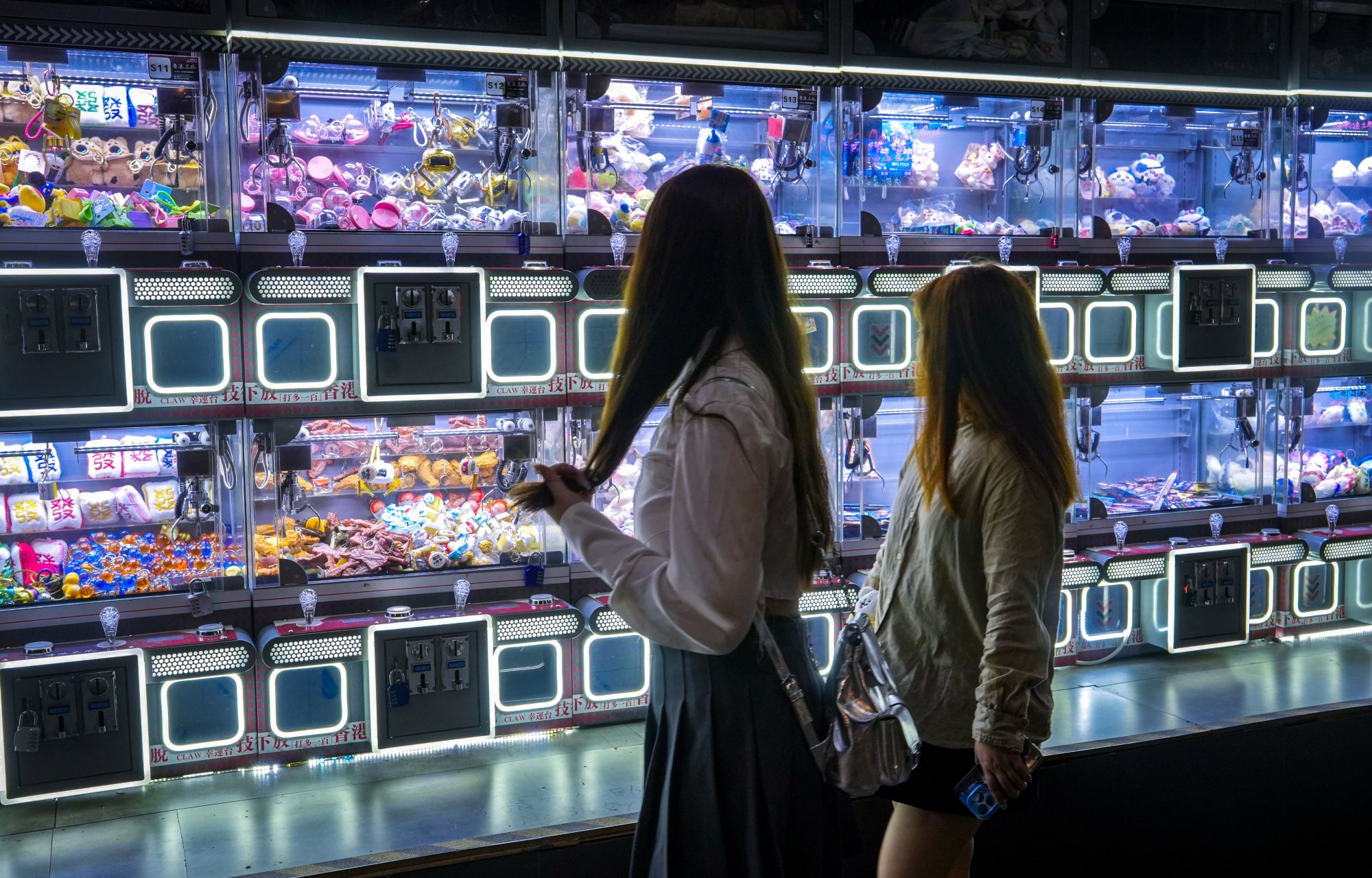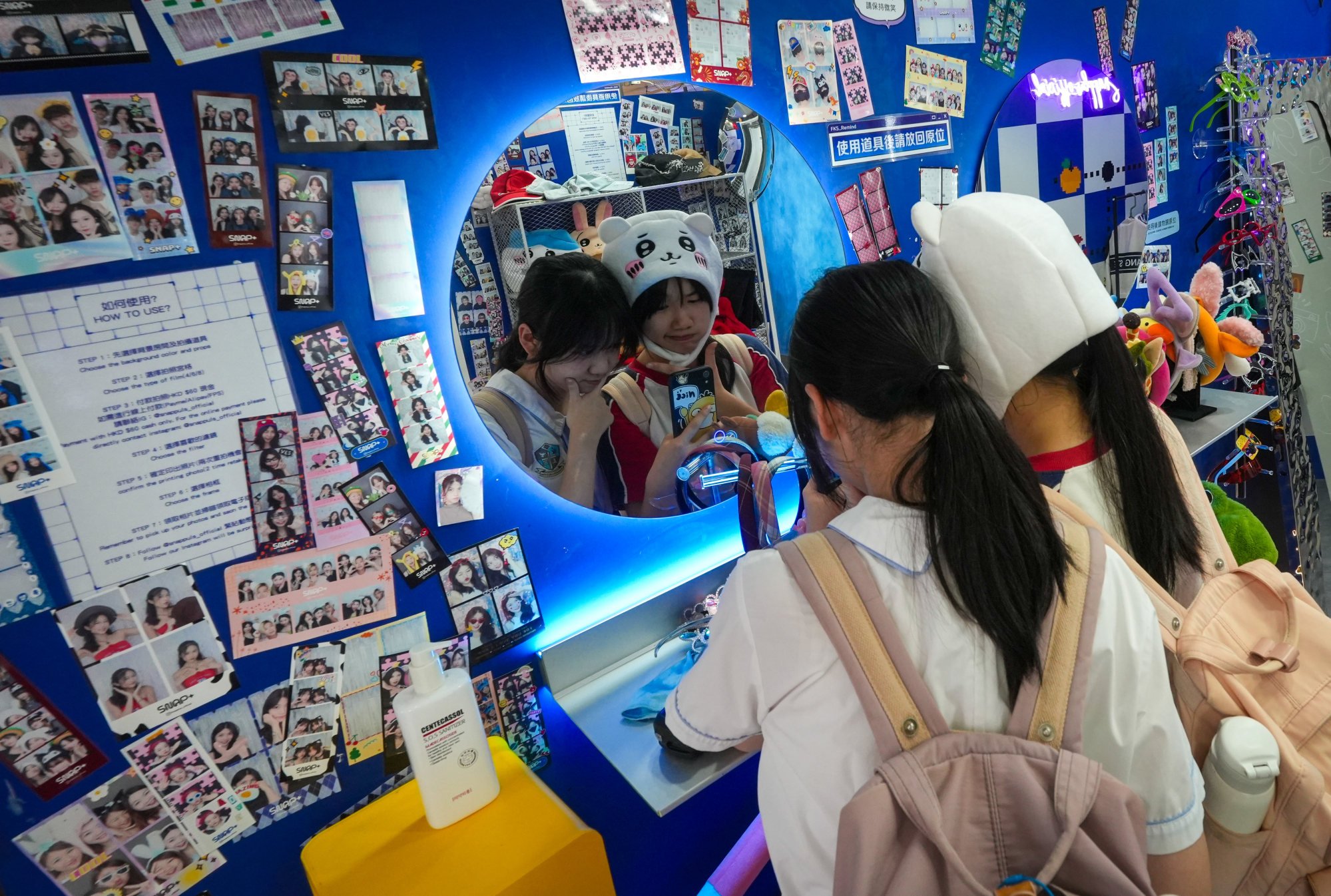SCMP's Vivian Au looks at the city’s changing retail scene, with thousands of empty shop lots that tell that these are desperate times.
In Mong Kok, one of Hong Kong’s most bustling commercial areas and long a magnet for visitors and locals alike, claw machines are the big draw these days.
There are at least 10 arcades of different sizes along a single stretch, all packed with brightly lit game boxes filled with gimmicky items that lure passers-by to take a chance to win a prize.
Do you have questions about the biggest topics and trends from around the world? Get the answers with SCMP Knowledge, our new platform of curated content with explainers, FAQs, analyses and infographics brought to you by our award-winning team.
The smallest arcades are just 100 sq ft. Larger ones occupy two floors of shop space.
Players pay at least HK$5 (64 US cents) to stand at their chosen box, manipulating joysticks that guide electronic claws to grab everything from keychains to bracelets, dolls, plush toys and even branded items.
Teenagers, young couples and families pack the arcades, which are unstaffed. Well-positioned cameras keep watch, doing away with the need for employees.
Mong Kok also has several self-service selfie shops, where customers walk in, select an outfit from a range of costumes and headgear, dress up and snap photos of themselves.
Argyle Centre, a shopping mall in a prime spot, has no fewer than five claw-machine arcades and six selfie shops.
These “experiential stores” have made their presence felt in Hong Kong at a time when traditional shops have closed down, leaving countless street-level premises locked up and vacant.
A rising number of small and medium-sized enterprises (SMEs) are said to be on the brink of collapse, with the city’s battered retail industry facing bleak prospects for recovery any time soon.
Retail sales volumes shrank by 11.8 per cent year on year to HK$29.1 billion in July, marking a contraction for the fifth consecutive month, according to authorities.
The overall retail vacancy rate eased slightly to 9.6 per cent in March from 10 per cent in the same month last year, according to property agency Midland IC&I.
Economists and scholars agreed that the city’s retail scene was going through a transition, and might need to diversify beyond traditional ways of doing business and attracting customers.
They saw the rise of “experiential stores” as an indicator of consumers’ changing habits, as many were shopping online or travelling to mainland China to stretch their dollars.
As for the city’s closed shops, landlords weighing mortgage issues preferred to keep their premises empty rather than lower rents and attract new tenants. At best, some were willing to rent on a short-term basis, including to the arcades and selfie shops.

Few takers for street-level shops
What has proven alarming to Rickey Chan Chi-po, managing director of property agency Dorbo Shop, is the persistent high vacancy rate of street-level shops in prime commercial areas.
The number of monthly transactions to rent street-level shops was at its worst in nearly three decades, he said.
There were also only about 70 sales transactions each month for such ground-level properties from January to August, merely a tenth of those done during the peak years of 2010 to 2013.
He said the number of vacant street-level shops had swollen to more than 7,000 in the city’s four prime districts of Central, Tsim Sha Tsui, Mong Kok and Causeway Bay.
These shops, ideal for attracting passers-by, were always the top choice of retailers. Despite rents coming down by 70 per cent from the peak, he said, there were few takers.
“The writing is on the wall for the retail industry, given the high vacancy rate,” he said.
He added that some landlords preferred to rent their shops in short-term contracts to cover their property management expenses.
Short-term rentals were typically only 20 per cent of regular rates, which had led to the rise of claw-machine arcades and selfie shops that require minimal investment.
Teen earns HK$100,000 a month
Teenage entrepreneur To Cheung*, 17, went from being a claw machine “addict” to running an arcade with a partner.
He said he could not resist the claw machines brimming with his favourite limited edition Disney stuffed toys and spent HK$5,000 a month on his hobby over the summer holiday.
“I have gradually become addicted to the excitement of playing at the arcades,” he said.
Six months ago, he and a friend invested HK$5,000 to rent a claw machine of their own, charging others to try their luck at it. They now have five at a small arcade in Lai Chi Kok.
“The investment is minimal, as it only covers the claw machine fees and the dolls,” he said.
Business has been so brisk that To, who is still in secondary school, claimed he earned around HK$100,000 each month.
Claw machine fan Joey Chew, a civil servant in her 20s, said she did not set a spending limit for indulging in her hobby.
“I usually rush over to the arcade when I spot my favourite Sanrio toys,” she said.
She added that young Hongkongers’ spending habits had changed and they preferred shopping online to going to bricks-and-mortar stores.
Little hope for better times ahead
The changes in Hong Kong’s retail scene have hit home with Michael Tien Puk-sun, lawmaker and founder of the G2000 chain of casualwear shops.
He said he was planning to gradually close a third of the brand’s 40 stores from this year as landlords were not willing to bring down rents by 20 per cent to 30 per cent.
“Those shops are operating at a loss, so I’ve decided to close them,” he said.
Pessimistic about the retail sector’s prospects, he said the city had been affected by the decline in visitors, particularly from mainland China.
“Hong Kong is facing a period of structural change,” he said, adding that he could not see the day when the economy would improve.
The only hope lay in innovation and lower rents for physical stores. Tien said he would reopen and expand his physical shops only if rents came down.
Vera Yuen Wing-han, a lecturer at the University of Hong Kong’s business school, said another reason for the retail crisis was Hongkongers’ declining consumption power.
The wave of emigration in recent years greatly affected the purchasing power of residents, she said.
More than 290,000 residents have left for places including Britain, Canada, Australia and Taiwan since Beijing imposed the national security law in Hong Kong in 2020.
Most were from middle-class families with strong purchasing power.
Yuen said the trend of residents going across the border to shop and eat out, on top of the rise of online shopping, had also contributed to the closure of the city’s shops.
However, she noted that developed regions tended to have slower growth, and that was the situation in Hong Kong now.
Given the retail industry’s struggles, questions have also emerged as to whether the city is experiencing the “lipstick effect”, an economic theory which suggests cash-strapped consumers are more likely to buy small indulgences such as affordable luxury brand lipstick while making cutbacks elsewhere.
Hong Kong’s economy expanded by 3.3 per cent in the second quarter which is slightly exceeding growth recorded in the first three months of 2024, according to data released in July.
A government spokesman said at that time that total exports continued to exhibit strong growth supported by external demand for goods, but the performance of different sectors was expected to vary.
The spokesman also said that private consumption expenditure declined slightly, affected by changes in the consumption patterns of visitors and residents, and the strength of the Hong Kong dollar.
Authorities had earlier forecast the city’s full-year GDP growth to fall somewhere between 2.5 and 3.5 per cent.

Time for a shake-up
Kathy Lee, head of research at Colliers Hong Kong, said Hong Kong’s post-Covid-19 pandemic recovery had not been as expected, and the retail sector’s woes reflected that.
She said some landlords might be adopting a wait-and-see approach, which was why they preferred to keep their street-level shops empty or let claw machine arcades have them on temporary contracts.
“The nature of claw machine stores is similar to mask shops that usually require minimal investment as the places are usually without decor and staff,” she said, adding that the contracts tended to be for only months at a time.
Some landlords might not want to lower the rents for ground-level premises for mortgage reasons, she said.
She explained that those who owned commercial premises and street-level shops in the same building might worry that reducing the store rent could result in banks lowering the value of the buildings.
“Some landlords are investors whose properties can be mortgaged for loans, so they would not want to reduce the rents,” she said. “They would prefer leaving the street-level shops vacant.”
Other landlords were selective about the tenant mix of their buildings.
Lee said she expected Hong Kong’s transition period to last a while, adding that much depended on the adjustment of US interest rates and policies of the city and mainland governments.
Baniel Cheung, an adjunct assistant professor at HKU’s business school, said the sluggish economy was the result of a ripple effect from the economic cycle and two major crises – the 2019 social unrest in the city and the Covid-19 pandemic.
“Residents were not happy because of the crises and some chose to emigrate, resulting in a great decline in purchasing power,” he said.
Hongkongers’ consumption behaviour and habits had also been affected by the prolonged periods of restricted movement during the pandemic.
“Some residents became accustomed to staying in, while others are more cautious when they spend money,” he said.
And while the number of mainland visitors had fallen, more Hongkongers were crossing the border to shop and spend, he said.
He suggested that one way to address the current situation was to enhance the city’s industrial structure.
“Whenever significant economic issues arise, major reshuffles occur,” he said.
Shopping centres, for example, would have to adjust their business models by showcasing unique characteristics rather than all offering the same thing.
“The shopping malls in Japan are all distinct; some are renowned for their vintage elements, while others are known for trendy goods,” he said.
* Name changed at interviewee’s request.
More from South China Morning Post:
- Many Hong Kong small businesses are on the brink of collapse. Can they be saved?
- No plans to revive pandemic-era guaranteed loan scheme for SMEs: Hong Kong commerce chief
For the latest news from the South China Morning Post download our mobile app. Copyright 2024.





